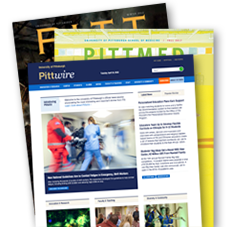What Does 'Now' Mean Now? University of Pittsburgh Convenes International Symposium on Modernity and Contemporaneity Nov. 4-6
PITTSBURGH—Have we entered an era for which we are just beginning to find a rudimentary vocabulary? What does it mean to inhabit the present historical moment, and what does it mean to represent it culturally and artistically? The tumultuous shifts of the recent past—the fall of the Berlin Wall and the end of the Cold War, the terrorist attacks of 9/11 and war in Afghanistan and Iraq—all point toward a world that has profoundly changed.
In an attempt to define the post-9/11 era, the University of Pittsburgh will bring together a group of the world's leading scholars and artists for a Nov. 4-6 symposium titled "Modernity and Contemporaneity: Antinomies of Art and Culture After the 20th Century" on the University campus and at the Carnegie Museum of Art. Full information and online registration is available at www.mc.pitt.edu.
Convening for the first time a group of world-class young artists, critics, historians, and curators with a distinguished cast of leading philosophers, social theorists, and cultural historians, the symposium will explore key questions about the relationships of the visual arts to modernity, postmodernity, and contemporaneity, and whether the world has crossed a threshold into a new period of culture and thought.
Artists participating in the symposium will exhibit work that organizers hope will help challenge the notions of "modern" and "contemporary" in the creation of art throughout the world. In the 20th century, "modern" and "postmodern" were used to describe periods and movements, and artists and academics are already seeking to articulate terms to describe the time in which we live.
Among the participants will be Fredric Jameson, Distinguished Professor of Comparative Literature at Duke University, well known as a theorist of postmodernism; Bruno Latour, director of the Centre de Sociologie de l'Innovation in the Ecole des Mines, Paris, and a philosopher in the history and philosophy of
science; Boris Groys, philosopher and aesthetician at the University of Karlsruhe, Germany, known as a theorist of art in post-Cold War Europe; Antonio Negri, professor at the University of Padua, Italy, a well-known contemporary moral and political philosopher; and Rosalind Krauss, Meyer Schapiro Professor of Modern Art History at Columbia University, widely known as a theorist of modern and contemporary art in the United States.
Conference conveners from Pitt are Terry Smith, Andrew W. Mellon Professor of Contemporary Art History and Theory in the Department of the History of Art and Architecture; Nancy Condee, director of the Graduate Program for Cultural Studies; and Okwui Enwezor, artistic director of Documenta 11, Kassel, Germany, and visiting professor in Pitt's Department of the History of Art and Architecture.
"It is a very exciting prospect," Smith commented. "Just imagine some of the smartest younger cultural activists in the world in a workshop with those acknowledged to be among the world's best minds, everybody working together to tackle what to me is the great question right now: In the aftermath of modernity and the passing of the postmodern, how are we to know and show what it is to live in the conditions of contemporaneity?"
The symposium will be held in conjunction with the Carnegie Museum of Art on the occasion of the 54th biannual Carnegie International contemporary art exhibition. Considered North America's most prestigious survey of new art work worldwide, the Carnegie International is known as a barometer of contemporary artistic directions. The exhibition will feature paintings, sculpture, photography, works on paper, and films and video by established and emerging artists.
Curator Laura Hoptman says that the artists she has chosen make art as "a meaningful vehicle through which to confront what philosophers have called 'the Ultimates'—that is, the largest, most unanswerable questions, ranging from the nature of life and death, to the existence of God, to the anatomy of belief."
The symposium is being jointly organized by Pitt's Department of the History of Art and Architecture and Graduate Program for Cultural Studies in cooperation with the Carnegie Museum of Art, the Center for Arts in Society at Carnegie Mellon University, the Warhol Museum, and the Mattress Factory.
Generous support has been provided by the Pittsburgh Foundation, The Heinz Endowments, and the University of Pittsburgh School of Arts and Sciences.
###
9/8/04/tmw
Media Resources
Schools of the Health Sciences Media Relations
For more information about Pitt's schools of dental medicine, health and rehabilitation sciences, medicine, nursing, pharmacy, and public health, click here >
To locate stories from health science schools prior to 2013, visit the UPMC news archives »
Urgent Question?
University of Pittsburgh news reps are available to answer urgent media inquiries. Outside of regular business hours (Mon-Fri, 8:30 a.m.-5 p.m.), please email us at media@pitt.edu.
News reps for University of Pittsburgh Health Sciences schools can be reached outside of regular business hours through the paging operator at 1+412-647-2345.


